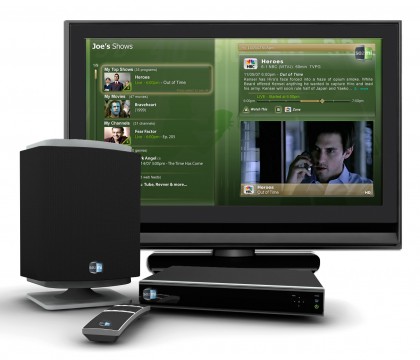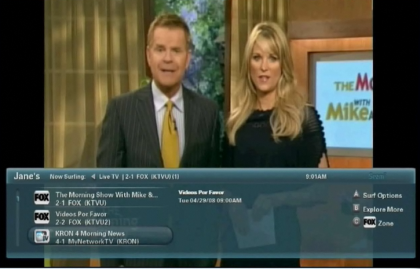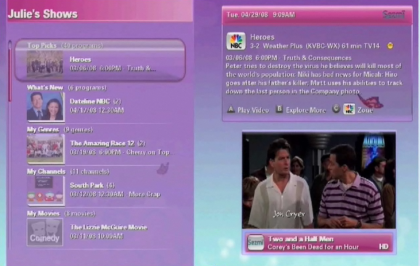Mari and I sat in on the Sezmi webcast briefing earlier this week and we’ve been slow in covering the news… As it turns out, this gives me an opportunity to provide some clarity in response to the widespread confusion.
At a high level, Sezmi (formerly Building B) is a video service with the goal of replacing our existing cable or satellite provider (television programming), and enhancing value by providing additional content (think Internet) and new methods of interaction.
Business Model
Consumers won’t be Sezmi’s direct customers. Sezmi’s plan is to offer sidelined broadband providers, telcos, and local television franchises a platform to offer television services (including advertising) without having to roll their own solution. They haven’t announced any distribution partners yet but, with imminent trials and plans to launch by the end of the year, there’s at least one company on the hook. Obviously, Verizon (FiOS TV) and AT&T (Homezone, U-verse) are spoken for. Given the mega quadruple-play alliance dissolution and forthcoming WiMax push, Sprint’s a likely target. I also wouldn’t be surprised to hear of Sezmi going after Qwest or even an Earthlink. Though, perhaps I’m thinking too big here…
Content Distribution
Sezmi will be using a hybrid approach to receive (and in many cases, provide) content including local over-the-air broadcasts, transmission of “cable” channels via leased (or partner/reseller) airwaves (see USDTV, rip), and the Internet. Sezmi hasn’t announced which premium content providers they’ve signed, though the USA Network was featured in the webcast.
Hardware
The initial Sezmi (leased) hardware package consists of an antenna unit which includes 1 terrabyte of storage, set-top box, and remote. The long-term goal is to transform the STB into more of a thin-client with the NAS providing most of the heavy lifting – and supporting multiple STBs throughout the home.
Software
For me, the most interesting portion of the webcast was a live demo of the Sezmi interface/experience – which they’re calling “TV 2.0.” (Many screengrabs below.) In addition to the DVR functionality you’d expect, Sezmi provides some innovative new ways of integrating, organizing, and presenting content. I wouldn’t go so far as saying they bring social networking to the TV (though, that’s one of the things they’re saying), but the per-user playlist plus sharing and community rating features are overdue and appreciated.
Odds
Several folks have asked me if these guys are going to succeed. It’s difficult to handicap the odds without knowing who Sezmi’s initial partners are. Which brings up the probable point of this pre-announcement: drumming up interest on both the potential distributor/reseller side and on the content provider side. Breaking into the TV business as a new player will be difficult (and expensive), and neither building out compelling solutions nor educating customers of the added value is guaranteed against the entrenched players. At the very least, they’ll need to sign resellers with some serious muscle to have a just shot at pulling it off.



“…Sezmi goal of replacing our existing cable or satellite provider and enhancing value by providing additional content (think Internet) and new methods of interaction.”
Man that makes someone like me ear’s perk up. Sounds really cool. I, like millions of people who live in apartments, am not allowed to choose my cable TV provider, and just use rabbit ears for local TV. Sezmi sounds like a step up to almost satellite level of service, but circumvents the restrictions on choice forced on me by my apartment complex. Id they will sell a stand alone one at the WalMart, I’ll buy one and check it out.
P.S. Jargon watch – “quadruple-play”. I assume that means my house phone, my mobile phone my ISP and my television?
A quadruple-play is something like a fumbleruskie… More myth, than reality. Now you see it, now you don’t. It’s rare, chances of success are slim, but if it works out pay off could be huge. ;)
Hmm, is it HD?
The main receiver with slave STBs sounds a lot like XStreamHD’s satellite system. Actually, the whole thing sounds similar, substituting terrestrial broadcast for satellite.
Personally I don’t see this working. The bandwidth needed to provide the equivalent of full satellite or cable services would be immense, far more than they’d be able to access on broadcast. Which means a lot of content pulled over broadband. And there is nothing to stop cable and satellite from competing on the feature front.
This is a very interesting concept, but it seems a bit before it’s time. We need faster bandwidth to get effective Web-to-TV streaming in acceptable resolutions. I guess high-roller FiOS homes could do it now, but I doubt most of the streamed content available right now would look good on a big-screen TV.
Still, I almost hope this works out. It would be great to have a competitor to cable in homes where satellite dishes don’t work and fiber isn’t available.
Ben, content will be provided in both in HD in SD – depending on source.
MZ, One of my first thoughts was regarding the hardware was those XStreamHD guys as well. From what I saw at CES, they’re also looking for partners.
Chris, a percentage of the content will be provided over leased airwaves (like the dearly departed Moviebean and USDTV). I do agree that bandwidth and quality of service could be an issue – It’s going to depend on how many channels are offered and what percent is HD. Though, they didn’t disclose much technical distribution details other than having experienced partners.